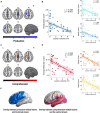Lesion Distribution and Early Changes of Right Hemisphere in Chinese Patients With Post-stroke Aphasia
- PMID: 34987373
- PMCID: PMC8722470
- DOI: 10.3389/fnagi.2021.632217
Lesion Distribution and Early Changes of Right Hemisphere in Chinese Patients With Post-stroke Aphasia
Abstract
The role of the right hemisphere (RH) in post-stroke aphasia (PSA) has not been completely understood. In general, the language alterations in PSA are normally evaluated from the perspective of the language processing models developed from Western languages such as English. However, the successful application of the models for assessing Chinese-language functions in patients with PSA has not been reported. In this study, the features of specific language-related lesion distribution and early variations of structure in RH in Chinese patients with PSA were investigated. Forty-two aphasic patients (female: 13, male: 29, mean age: 58 ± 12 years) with left hemisphere (LH) injury between 1 and 6 months after stroke were included. The morphological characteristics, both at the levels of gray matter (GM) and white matter (WM), were quantified by 3T multiparametric brain MRI. The Fridriksson et al.'s dual-stream model was used to compare language-related lesion regions. Voxel-based lesion-symptom mapping (VLSM) analysis has been performed. Our results showed that lesions in the precentral, superior frontal, middle frontal, and postcentral gyri were responsible for both the production and comprehension dysfunction of Chinese patients with PSA and were quite different from the lesions described by using the dual-stream model of Fridriksson et al. Furthermore, gray matter volume (GMV) was found significantly decreased in RH, and WM integrity was disturbed in RH after LH injury in Chinese patients with PSA. The different lesion patterns between Chinese patients with PSA and English-speaking patients with PSA may indicate that the dual-stream model of Fridriksson et al. is not suitable for the assessment of Chinese-language functions in Chinese patients with PSA in subacute phase of recovery. Moreover, decreased structural integrity in RH was found in Chinese patients with PSA.
Keywords: MRI; aphasia; language; right hemisphere; stroke; structural covariation.
Copyright © 2021 Fan, Gao, Zhang, Xin, Sang, Tan, Zhang, Li, Huang, Li and Chang.
Conflict of interest statement
The authors declare that the research was conducted in the absence of any commercial or financial relationships that could be construed as a potential conflict of interest.
Figures






References
LinkOut - more resources
Full Text Sources
Research Materials
Miscellaneous

